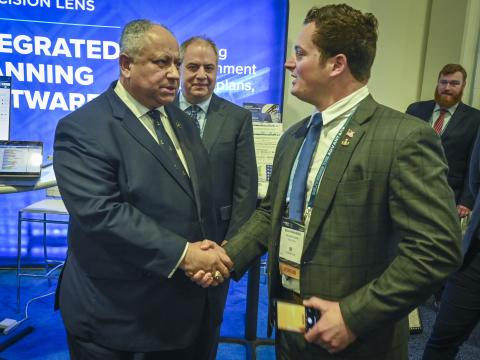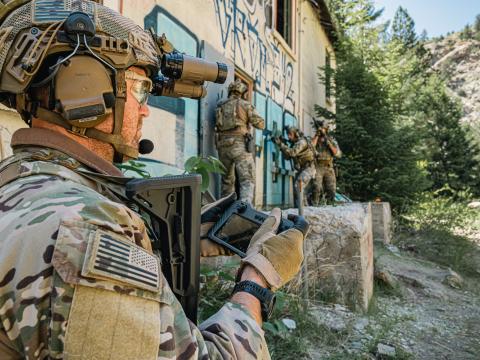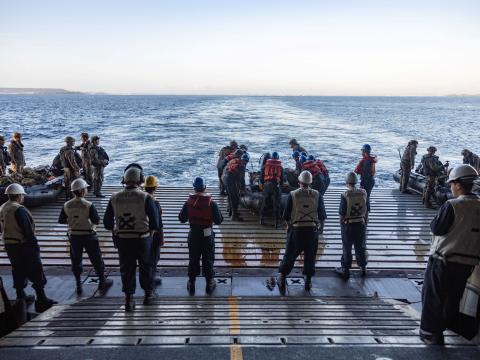Airborne Testbed Opens New Possibilities
Unmanned reconnaissance platform allows testing of sensors, datalinks and communications. 
The U.S. Marine Corps Warfighting Laboratory is using the SpyHawk unmanned aerial system (UAS) as a testbed to study new surveillance and communications technologies. The research is part of an effort to develop a UAS platform to support Marine forces at the echelons between battalion and headquarters.
The U.S. Marine Corps soon may have an additional set of airborne eyes available to help its warfighters on the ground. A technology development program is using a new type of robot aircraft to fill an operational gap between tactical- and headquarters-level forces. The platform will be used to assess a variety of sensors under operational conditions to find the right mix of systems to support troops in the field.
Managed by the Marine Corps Warfighting Laboratory in
The reconnaissance capability gap was identified in Tier II, the division level. The Marine Corps initially selected the ScanEagle UAS to address this deficiency; however, Capt. Funkhouser notes that ScanEagle was a leased system and that the service wanted its own platform.
In October 2006 the Marine Corps selected the SpyHawk UAS, manufactured by MTC Technologies in
A simple pneumatic launcher lofts the aircraft. Capt. Funkhouser explains that the launch system is less complicated than other types of launchers used for unmanned aircraft in the SpyHawk’s size range. The device consists of a tube inside a pipe, with the air charge coming from an accumulator tank, launching the UAS “like a piece of paper off of a straw.” The captain notes that simple systems are desirable for expeditionary operations. Another advantage of the SpyHawk is that the aircraft and its launcher and control station can fit into a CH-46 helicopter. He adds that the only thing that cannot fit into the helicopter is the UAS transport trailer.
An L-band datalink provides analog and digital connectivity between the aircraft and the groundstation at a range of 50 nautical miles. The analog component is used to transmit video imagery to the terminal.
The SpyHawk currently is powered by a Honda four-stroke gasoline engine. However, the Warfighting Laboratory is studying the use of a heavy fuel engine for the aircraft. The captain notes that a major program priority is determining how successfully a heavy fuel engine can be adapted and demonstrated on the UAS.
Capt. Funkhouser claims that in his personal operational experience, the SpyHawk is the best UAS airframe that he has worked with. He explains that it is easy to fly and that its simple design provides an extremely stable platform, which is necessary because it is a “truck to carry around a myriad of sensors.” The Tier II development program also will examine the SpyHawk’s payload capacity during the user assessment phase.
 |
| The SpyHawk UAS is undergoing a series of evaluations to verify its operational characteristics. The aircraft then will undergo tests with a variety of sensor packages, and developers will establish new tactics and operational procedures. If this technology demonstration is successful, it will transition to a development and procurement program. |
Capt. Funkhouser ultimately wants the SpyHawk to be intuitive to any 19-year-old warfighter required to control it. He states that a goal of the Marine Corps’ Tier I and II programs is to automate UAS flight systems to the point where the personnel operating them can be more focused on collecting sensor data than on flying the aircraft.
Although the SpyHawk has a maximum payload capacity of 20 pounds, currently it is equipped with only a 10-pound combination electro-optical and infrared sensor and laser designator. The captain says that the Marine Corps also is exploring the platform’s communications and data relay capabilities. Other potential applications include electronic signals intelligence, electronic warfare, hyperspectral imaging and synthetic aperture radar. He notes that as a concept demonstrator, the program will reveal what works and what doesn’t for the SpyHawk platform.
A major difference exists between Tier I and Tier III UAS systems, says Capt. Funkhouser. Small Tier I tactical platforms such as the Dragon Eye almost are considered as ordnance or “airborne binoculars.” They are inexpensive, have limited range, fly at very low altitudes and offer few airspace deconfliction issues during operations. He observes that local air officers can control or manage Tier I UAS operations. But the larger Tier II and III UAS types must file flight plans and interact with a variety of manned platforms because of the higher altitudes in which they operate.
The SpyHawk currently is undergoing acceptance test procedures, but the captain notes that the program has been slightly delayed because of a recent ruling by the U.S. Federal Aviation Administration (FAA). In February the FAA published regulations prohibiting UAS operations in
The FAA ruling has caused the program to suspend its flight tests temporarily and to relocate to a military reservation. The captain’s group currently is looking for a facility with restricted airspace to resume operations. He explains that the government cannot accept the SpyHawk as a military platform until the acceptance tests are complete.
Once acceptance testing is finished, a cadre of Marines will be trained to operate the UAS, after which a limited technical assessment will begin. The goal of this second effort is to test each of the UAS’ factory specifications to the limit. Capt. Funkhouser explains that commercial acceptance tests are more flexible about operational requirements, but the limited technology assessment will verify the aircraft’s exact operational specifications. The technology assessment will be followed by limited user tests in the field examining the utility of a variety of payloads under operational conditions. He says that the user assessments, which are scheduled for this fall, will include a great deal of direct warfighter input.
The program’s timetable and priorities are laid out in the Joint Tier II UAS Initial Capabilities Document. Capt. Funkhouser notes that this document also follows the U.S. Defense Department’s UAS road map (SIGNAL Magazine, December 2005), which provides a robust outline for future experimentation.
Web Resources
Marine Corps Warfighting Laboratory: www.mcwl.usmc.mil
MTC Technologies: www.mtctechnologies.com
Arcturus UAV: www.arcturus-uav.com


